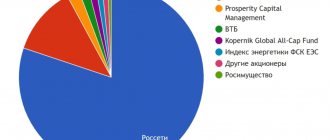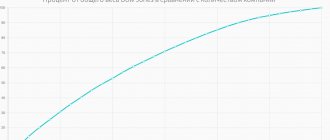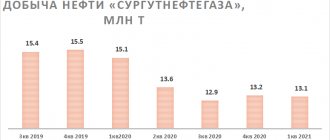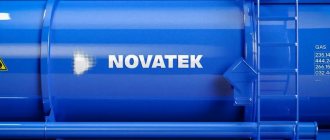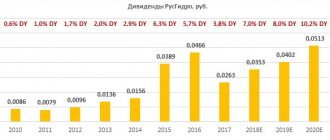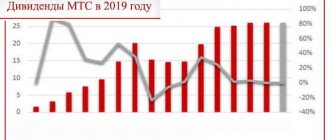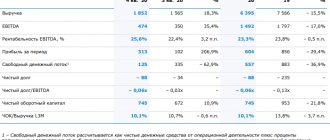Gazprom. Time for a correction, but the outlook is positive
Address for questions and suggestions about the site: [email protected]
Copyright © 2008–2021. LLC "Company BKS" Moscow, Prospekt Mira, 69, building 1 All rights reserved. Any use of site materials without permission is prohibited. License for brokerage activities No. 154-04434-100000, issued by the Federal Commission for the Securities Market of the Russian Federation on January 10, 2001.
The data is exchange information, the owner (owner) of which is PJSC Moscow Exchange. Distribution, broadcast or other provision of exchange information to third parties is possible only in the manner and under the conditions provided for by the procedure for using exchange information provided by Moscow Exchange OJSC. Brokercreditservice Company LLC, license No. 154-04434-100000 dated January 10, 2001 for brokerage activities. Issued by the Federal Financial Markets Service. No expiration date.
* The materials presented in this section do not constitute individual investment recommendations. The financial instruments or transactions mentioned in this section may not be suitable for you and may not correspond to your investment profile, financial situation, investment experience, knowledge, investment objectives, risk appetite and return. Determining the suitability of a financial instrument or transaction for investment objectives, investment horizon and risk tolerance is the responsibility of the investor. BKS Company LLC is not responsible for possible losses of the investor in the event of transactions or investing in financial instruments mentioned in this section.
The information cannot be considered a public offer, an offer or an invitation to purchase or sell any securities or other financial instruments, or to make transactions with them. The information cannot be considered as guarantees or promises of future investment returns, risk levels, costs, or break-even of investments. Past investment performance does not determine future returns. This is not an advertisement of securities. Before making an investment decision, the Investor must independently assess the economic risks and benefits, tax, legal, and accounting consequences of entering into a transaction, his readiness and ability to accept such risks. The client also bears the costs of paying for brokerage and depositary services, submitting orders by telephone, and other expenses payable by the client. The full list of tariffs of BCS Company LLC is given in Appendix No. 11 to the Regulations for the provision of services on the securities market of BCS Company LLC. Before making transactions, you also need to familiarize yourself with: notice of risks associated with transactions on the securities market; information about the client’s risks associated with making transactions with incomplete coverage, the occurrence of uncovered positions, temporarily uncovered positions; a statement disclosing the risks associated with conducting transactions in the market for futures contracts, forward contracts and options; declaration of risks associated with the acquisition of foreign securities.
The information and opinions provided are based on public sources that are recognized as reliable, however, BKS Company LLC is not responsible for the accuracy of the information provided. The information and opinions provided are formed by various experts, including independent ones, and opinions on the same situation can differ radically even among BCS experts. Given the foregoing, you should not rely solely on the materials presented at the expense of conducting independent analysis. BKS Company LLC and its affiliates and employees are not responsible for the use of this information, for direct or indirect damage resulting from the use of this information, as well as for its accuracy.
Gas consumption in the world. Long-term forecasts and key markets
Gazprom is confident that in the long term, global gas consumption will continue to grow. In the next 20 years, natural gas will become the leader in terms of absolute contribution to meeting growing energy demand, ahead of renewable energy sources (RES). Contribution of natural gas to meeting new demand for energy energy in 2020-2040
will be 39% compared to 34% for renewable energy sources. The share of natural gas in the global energy balance will increase from about 24% in 2021 to 27% in 2040. This creates a favorable market environment for the further development of Gazprom in the long term. Gazprom considers the domestic Russian market, the markets of Europe and China as key sales markets. In Russia, the share of natural gas in the energy balance is about 54%, while Gazprom supplies more than 60% of the total gas consumption in the country. Plans for the development of gas supply and gasification of Russian regions involve, among other things, the transfer of coal-fired power generating capacities to gas. From the point of view of reducing the carbon footprint, switching from coal to gas is significantly more effective than replacing gas with renewable energy sources. Thus, the reduction in CO2 emissions when replacing gas with RES does not exceed 400 g CO2/kWh, and when replacing coal with gas - from 445 to 620 g CO2/kWh. Thus, Gazprom’s work to develop gasification makes a significant contribution to the low-carbon development of the Russian economy. Gazprom's key export markets are Europe and China. Taken together, in both of these markets, gas demand will increase from 865 billion m3 in 2021 to 990 billion m3 in 2030, and the total export niche will increase from 471 billion m3 in 2021 to 550 billion m3 in 2030. At the same time the dynamics in these markets will vary. Gazprom expects that due to the energy transition, the demand for gas in Europe, even with falling domestic production, will decrease, but not dramatically - from 517 billion m3 in 2021 to 489 billion m3 in 2030. In China, the demand for gas will continue to grow, even with increasing production, which will lag behind demand, which will rise from 348 billion m3 in 2021 to 501 billion m3 in 2030. Gazprom does not see a significant threat to its positions in Europe from liquefied natural gas (LNG), including .h. thanks to more environmentally friendly supplies. According to Gazprom estimates, pipeline gas supplies to Europe from Russia via new gas pipelines have a minimal carbon footprint compared to LNG. For comparison: the carbon footprint of gas supplies to Europe via the Nord Stream gas pipeline is 6.3 g of CO2 equivalent per 1 MJ, while LNG from the USA is 23.8 g. Portfolio of long-term contracts of Gazprom gas supply contracts by 2021, covers 25% of the total gas demand in Europe and China by 2030. The potential export capacity of the company’s modern gas pipelines accounts for about 30% of the demand in these markets. O. Aksyutin clarified that currently the export capacity of existing and prospective export gas pipelines to Europe and China is 330 billion m3/year, of which more than 60% is in Europe. Given the dynamics of demand, Gazprom does not yet plan to build new pipeline facilities for exporting gas to Europe. In the eastern direction, on the contrary, capacity expansion is planned - to the MGP Power of Siberia-1 launched in December 2021 (eastern route for gas supplies to China), in the future the MGP Power of Siberia-2 (western route) will be added, and potentially to the MGP Power of Siberia 3 (Far Eastern route).
Recycling. Ethane, LNG and hydrogen
Gazprom considers multi-component gas from a number of fields in the Nadym-Pur-Taz region, as well as the Kovyktinskoye and Chayandinskoye fields in Eastern Russia, as a way to extend the value chain and diversify the product portfolio through new projects in the processing segment. The creation of 2 large gas processing clusters - the Amur Gas Processing Plant (GPP) in the East and a complex for processing ethane-containing gas and producing LNG in the Ust-Luga region in the West will allow Gazprom to effectively monetize multi-component gas. In addition, the construction of an LNG production complex in the area of the Portovaya compressor station with a capacity of 1.5 million tons per year is being completed. Gazprom views LNG, first of all, as a way to diversify the directions of gas supplies, opening access to markets to which exporting pipeline gas is impossible or economically unfeasible. The LNG plant of the Sakhalin-2 project operates at a capacity exceeding its design capacity; gas supplies are carried out only to countries in the Asia-Pacific region and are therefore characterized by minimal transport distance, low carbon footprint and high competitiveness. In the long term, Gazprom expects that gas will be increasingly used to produce hydrogen, while technologies exist to minimize and even completely eliminate CO2 emissions when producing hydrogen from methane. Formally, such hydrogen is considered “blue” by color classification, i.e. not as correct as “green” hydrogen, produced by electrolysis of water using energy from renewable energy sources. Gazprom considers this classification discriminatory, focusing on the carbon footprint of production, rather than the feedstock and production technology. In addition, low-carbon hydrogen production from natural gas, at the current level of technology development, has a significantly lower cost than that based on renewable energy sources. It is difficult to say whether Gazprom will be able to convey its vision of the issue to potential consumers of hydrogen. Gazprom plans to achieve carbon neutrality by 2050.
The resource base is being prepared
Gazprom has a sufficient resource base to meet growing demand. At the same time, the company is developing its resource base based on traditional fields, which are characterized by economic and environmental advantages compared to unconventional ones. The main increase in production in the area of the Unified Gas Supply System (UGSS) of Russia will be ensured by the development of a new gas production center on the Yamal Peninsula (Bovanenkovskoye, Kharasaveyskoye and other fields). At the same time, Gazprom continues to develop production capacities in the areas of the Ob and Taz bays, as well as in Nadym -Pur-Taz region, where the emphasis is shifting to deeper horizons with ethane-containing gas. The demand for gas in eastern Russia and in export markets in the eastern direction will be provided by the fields of Eastern Siberia (Kovyktinskoye and Chayandinskoye, which are the resource base of the Power of Siberia-1 international gas pipeline) and Far East. As part of the Eastern Gas Program, the Sakhalin gas production center is being created, which includes the development of the Kirinskoye and Yuzhno-Kirinskoye fields on the shelf of the island. Sakhalin. Particular attention is paid to the Yuzhno-Kirinskoye field, which is under US sanctions, and therefore Gazprom independently began developing an underwater production complex. It was previously reported that the deadline for the development of the Yuzhno-Kirinskoye field has been shifted to 2024, but A. Fick assured that the project is on schedule, and the commissioning dates for the field have not been revised. Thus, the first gas launch at the Yuzhno-Kirinskoye field is scheduled for 2023.
Dividend issue
Of course, Gazprom is unlikely to be able to achieve at least last year’s level of supplies based on the results of this year. And according to the results of the second half of the year, too. According to Alexander Frolov, the volumes could potentially be comparable to the level of 2021 (by the way, which became a record in the history of Gazprom supplies). At that time, consumers from non-CIS countries received 193.9 billion cubic meters of gas from Russia. That is, in a six-month perspective, we are talking about approximately 97 billion cubic meters.
Gazprom itself plans to make a decision on dividends based on the results of the entire 2021 year. However, only the size will be discussed. The question of “to pay or not to pay” is not worth it, the concern notes. “In conditions when many companies refuse to pay dividends or postpone them, we continue to adhere to the previously announced plans and confirm that the dividend policy remains the company’s priority,” Famil Sadigov emphasized, pointing out that according to the results of the first half of the year, the dividend base amounted to 216 billion rubles .
At the same time, as Sergei Khestanov notes, the decision on the size of dividends will most likely be a political rather than an economic issue. After all, the largest recipient of payments should not be anyone, but the state. At the same time, given the unusual nature of this year, he does not exclude the option of reducing dividend payments.
